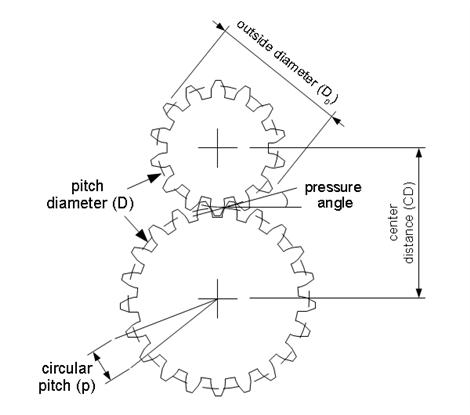
[Dustyn Roberts] takes us through the process of designing gears for a specific application. Using Inkscape and Ponoko.com [Dustyn] takes us from equation to physical gear. While there is a plugin for Inkscape that allows you to basically drag and drop gears, this writeup will take you through the math to get exactly what you need. Those laser cut wooden gears are pretty cool looking too.
















Wow! This entry is really engaging!
Dear god…I’ll get my coat…
I was just about to search for this, thanks!
any one know of any good complete CAD software for hardware?
what sort of hardwear? Erm autocad? solidworks?
This is totally on topic to what I’ve been getting ready to do, some gear designs in SolidWorks.
Thanks, HAD.
Inkscape may not be the best app to work in, try Blender and keep a copy of this book handy:
http://homepage.ntlworld.com/r.burke2/precision_modelling1.html
There’s tonnes of info on this sort of thing at Thingiverse.
Simon
might be useful to mention OpenSCAD ( openscad.org )
Neat. Very cool service for hobbyists/prototyping.
As far as specific design parameters go, for things like fatigue life there’s an incredible amount of parameters that go into making gears. As a student of mechanical engineering, I’ve found Autodesk Inventor 2010/2011 to be good (free 13-month licenses for students, then you have to upgrade… forces you to want your future bosses to buy you the latest and greatest). In the gear design calculator, it simplifies the math into a nice interface
http://woodgears.ca/gear_cutting/template.html
this is what I use
mungewell: That looks like an awesome resource. I love using Blender, but I’d never seen that book before. Downloading now, thanks!
The article imagine looks like it could be a scan out of one my engineering text books…
I often forget that really basic useful engineering information like this can sometimes be hard to find on the internet.
I used the same as TJ. when I read the article I was looking for that link before I saw it was done here by TJ. It´s the easy way and I like it.
mungewell – thanks for that link. I have thought of using blender for modeling parts for my cnc, but I never found a guide that cared about precision.
you know what really grinds my gears?
I still have nightmares about working all that stuff out longhand during my college days way too many years ago…
They used to give us exercises like working out the design of the cutters for a gear-hobbing machine to make gears given the information in that diagram.
We were allowed a slide-rule, that was all.
wanders off muttering about “kids today don’t know they’re born” etc…
@TJ good to see someone else mentioning woodgears.ca
He has a youtube video explaining the software too, as well as giving some ideas on how to cut them by hand iirc.
I like HAD, but my EE skills are very limited.
I’m a Mech Eng / Product Designer, so finally, something that I can comment on!
Visualisation packages (2D or 3D) are not reliable for engineered parts. 2D Vector packages can be OK, but they have a number of shortcomings. 3D visualisation packages are mesh (point and facet) based so have a finite resolution and have no history tree or parametrisation, so editing is nigh on impossible.
AutoCAD costs thousands of pounds and it’s dogshit. There aren’t many good free packages around. However, they do exist….
For 2D:
Fully parametrised drawing can be done in Solid Edge Drafting. It’s way better than AutoCAD IMHO, and completely free:
http://www.plm.automation.siemens.com/en_us/products/velocity/solidedge/free2d/index.shtml
For 3D Solid Modelling:
PTC CoCreate Modeling Personal Edition:
http://www.ptc.com/offers/tryout/pe2.htm
or Alibre Design Xpress:
http://www.alibre.com/
They don’t tell you but the fully functioning trial version reverts to Alibre Design Xpress after 30 days.
http://mkt.alibre.com/testdrive
Hope that helps some of you…
I learned Pro/E in college back in ’96 and worked for them for a few years. Now 10 years later I download a copy of Alibre Design Xpress and I’m amazed at how good a free package can be. I convinced my boss to upgrade me to the $500 edition and I’ve been very happy with it.
Great feedback everyone! A few follow ups…
@diago – I’ve been in touch with Alibre and they’ve discontinued the free Xpress version. However, after the free 30 day trial you can spend $99 for their “Personal” license which is extremely capable. I did and it’s great to have as a resource. Also thanks for the Solid Edge 2D drafting and PTC CoCreate links – those weren’t on my radar.
@mungewell – Great link to the Precision Modeling book! I haven’t seen that before.
Good quick reference some of you might find useful:
http://www.engineeringtoolbox.com/
Wow, there’s some great discussion going on here. Awesome links to some great software I’ve never heard before. Much appreciation to you good folks.
Checkout GearoticMotion
http://www.buildlog.net/blog/?p=40
The upper gear in the article photo has an even number of teeth, which is something you’ll never see in the wild. Gears always have odd numbers of teeth, so they’ll wear evenly. Look at the gears on bicycles, for instance.
I’m a Mechatronic engineering student. During Machine Design, we had to learn how to design transmission systems (gears, chains, V-Belt, Timing belt etc) by hand!
Using a book such as “Shigley’s Mechanical Engineering Design” (This is available on torrent). There are a lot of little pitfalls when it comes to gearing design, so it might be a good read just to get a few pointers. Try to be a pro and design your drive with nothing but a calculator and pencil ;) – It’s very possible!
When we are actually implementing it into a design, we usually use a CAD program such as ProENGINEER or CATIA with the mechanical system plugins installed, which can give real-time calculations on the design.
bbot:- generally an odd number of teeth is only mandatory on gears with less than 20 teeth (so yes, the top gear in the photo is a bit of a no-no). It’s not entirely unreasonable to have a 30-tooth gear, but its generally bad practice as it can cause poor power transmission.
Hey Caleb, thanks for the very useful post.
The Link to MAKE is Dead
Still dead in 2018!
B^)
nice well guidness….. we need more to known about engineering….thanks
the MAKE link if anyone’s interested ;p
https://makezine.com/projects/make-your-own-gears/
( yup, I’m tired .. )
MAKE link ( sorry for dbl post )
-> https://makezine.com/projects/make-your-own-gears/